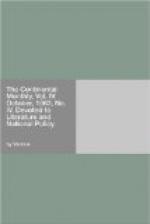2. Letter from the Secretary of the Treasury to the Chairman of the Committee of Ways and Means, in relation to the Issue of an Additional Amount of United States Treasury Notes.
3. Report of the Secretary of the Treasury on the State of the Finances of the United States for the Year ending June 30, 1862.
4. The Tariff Question considered in regard to the Policy of England and the Interests of the United States. With Statistical and Comparative Tables. By ERASTES B. BIGELOW. Boston: Little, Brown & Co. 4to, pp. 103 and 242.
5. The Bankers’ Magazine and Statistical Register. New York, monthly, 1861-2. Edited by J. SMITH HOMANS, jr.
The Bank of England was created during the urgent necessities of national finance. It was a concession of a valuable privilege to a few rich men, in consideration of their loaning the capital to the treasury. ’The estimates of Government expenditure in the year 1694 were enormous,’ says Macaulay, in his fourth volume. King William asked to have the army increased to ninety-four thousand, at an annual expense of about two and a half millions sterling—a small sum compared with what it costs in the year 1862 to maintain an army of equal numbers.
At the period of the charter of the bank, the minds of men were on the rack to conceive new sources of revenue with which to meet the increased expenditures of the nation. The land tax was renewed at four shillings in the pound, and yielded a revenue of two millions. A poll tax was established. Stamp duties, which had prevailed in the time of Charles II had been allowed to expire, but were now revived, and have ever since been among the most prolific sources of income, yielding to the British Government in the year 1862 no less than L8,400,000 sterling. Hackney coaches were taxed, notwithstanding the outcries of the coachmen and the resistance of their wives, who assembled around Westminster Hall and mobbed the members. A new duty on salt was imposed, and finally resort was had to the lottery, whereby one million sterling was raised. All these resources were not sufficient for the growing wants of the Government, and the plan of the Bank of England was devised to furnish immediate relief to the finances. Montague brought the measure forward in Parliament, and ‘he succeeded,’ as Macaulay remarks, ’not only in supplying the wants of the state for twelve months, but in creating a great institution, which, after the lapse of more than a century and a half, continues to flourish, and which he lived to see the stronghold, through all vicissitudes, of the Whig party, and the bulwark, in dangerous times, of the Protestant succession.’
The birth of the bank and the birth of the English national debt were both in King William’s time. In 1691, when England was at war with France, the national debt unfunded was L3,130,000, at an annual interest of L232,000. In 1697, at the Peace of Ryswick, this debt had swollen to L14,522,000. At the Peace of Utrecht, in 1713, it had reached L34,000,000. The war with Spain in 1718 brought it up to forty millions sterling. And here it might have rested, had the advice of Shakspeare been followed:




